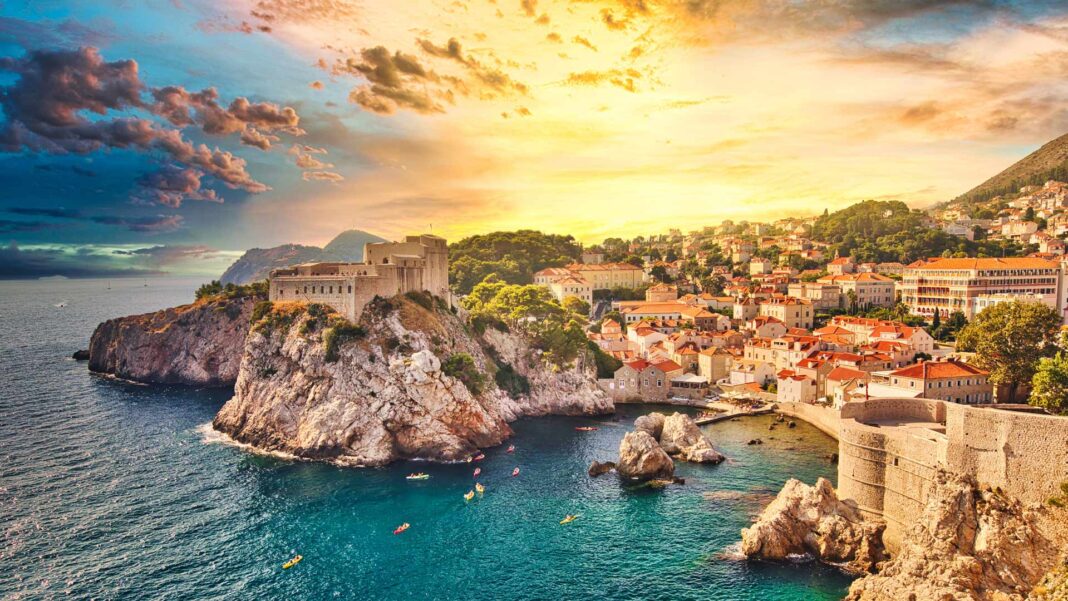Trip To DUBROVNIK:
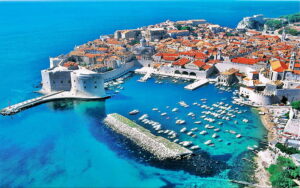
Dubrovnik is a vaunted city. Every building here is a Renaissance monument, every street is a journey through time, every passerby is a celebrity (this is an exaggeration, but a small one). In addition to all this, Dubrovnik has acquired excellent hotels, luxury and expensive not only by Croatian standards. If you need a beautiful old town, a luxury hotel and a beach on the shore of a warm sea for a family vacation, Dubrovnik is just right. Let’s make a reservation right away: you won’t find quiet beaches and all inclusive in hotels here. Holidays with children in Dubrovnik have a completely different charm.
Dubrovnik on the map of Croatia:
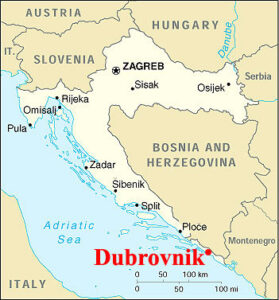
The city of Dubrovnik is a resort in the south of Croatia, on the Adriatic coast. The administrative center of the Dubrovnik-Neretva County, the main resort of South Dalmatia. The distance from Dubrovnik to Zagreb is 600 km, to Split – 230 km, to other resorts in the region: Cavtat – 21 km, Mlini – 12 km, Slano – 34 km. Distance to the islands: Kolocep – 11 km, Lopud 15 km, Mljet – 79 km, Korcula – 120 km. Only 50 km separate Dubrovnik from the city of Herceg Novi (Montenegro). On the Dalmatian coast, where Dubrovnik is located, there were once oak groves. Among them, in the 7th century, a city was built, called Dubrava. The Slavic name had an official Italian version – Ragusa, which was the name of the city until 1918. Unofficially, Dubrovnik was called the Slavic Athens: the settlement in the oak grove became the center of the development of Croatian culture. Holidays with children
Those who choose to holiday in Dubrovnik have a refined taste: this city is not called the pearl of the Adriatic for nothing.
And those who come to Dubrovnik with children have a refined sense of smell: it is not so easy to choose a place where, in addition to architectural monuments, there are wonderful beaches, an incredibly blue sea and islands located so invitingly close to the shore.
Today you can sunbathe and swim, tomorrow – pace the fortress walls of the old city, the day after tomorrow – go on a trip to the islands, every day being surprised at how much fits in a small city and its immediate surroundings.
This attractiveness of Dubrovnik has a downside. In the high season, especially in July-August, the city is crowded with tourists, it is not easy to find a free place on the beach and in a restaurant. To have a peaceful holiday with a child, you need to choose the beginning and end of the season for your trip, or even come in winter. It should be added that the expensive and respectable Dubrovnik is not very suitable for holidays with small children. There are almost no family hotels, the city has few playgrounds, and the usual resort entertainment is absent. Such conditions are suitable for a holiday with a baby, for whom the only thing important is the presence of parents nearby, or with a teenager who can be interested in ancient architecture. However, if you dig around, you can find a lot of interesting things for children in Dubrovnik. We have already collected information on what you can do during your holiday in this city, so that it will please your whole family.
When is the best time to go:

When is the best time to go to Dubrovnik? A trick question: the most obvious answer is not necessarily the right one. The high season in Dubrovnik generally coincides with the beach season, and there are two reasons for this. Firstly, many people take their vacation in the summer. Secondly, tourists love the opportunity to visit one of the most beautiful cities in Croatia and sunbathe on the Adriatic coast. But here you need to take into account that in July-August Dubrovnik is flooded with tourists, and at the same time, there is often a strong heat.
For a trip with children, it is better to choose May, June or the first half of autumn, when neither the heat nor the crowds of vacationers are too much.
But if the beaches are of secondary importance to you, then you don’t need to be tied to the opening of the season in Dubrovnik. In late autumn, winter and spring, there are few tourists in the city, hotel prices are noticeably lower, and the weather, although changeable, is quite suitable for walks. In addition, two bright events take place in winter: in February, Dubrovnik celebrates the day of St. Blaise, the patron saint of the city, and then comes the carnival, which lasts a whole month. The only problem with the low season is the lack of direct flights, so you have to get to Dubrovnik with transfers. Summer, however, is also filled with festivals. The most famous is Dubrovačke ljetne igre in July-August, when the city turns into a concert and exhibition venue, and all sorts of entertainment is organized for children.
Weather and climate:

Dubrovnik’s location is pleasing to the eye, even if you just look at the map: the city is located at the same latitude as Bulgaria’s Sunny Beach, which means sunny summers and warm seas are guaranteed here. Dubrovnik has a Mediterranean climate, mild, without extreme heat in the summer and without frost in the winter. Summer lasts for a good four months, from mid-May to mid-September, and sometimes extends into October. From October to April, Dubrovnik is not so much cold as damp: at this time, the resort is generously drenched with rain. You can plan a vacation in Dubrovnik for April if you want to travel around Croatia, and not lie on the beach. The medieval city is very beautiful in bloom with olive and orange trees, and the air temperature of +15-20°C is favorable for walks. Rains in April are quite frequent, but quickly end. May is a good time to travel to Dubrovnik with a baby. It is still far from hot, and sunbathing on the beach is very pleasant. The air warms up to +20-23°C, but the sea is still cold. Be sure to pack warm clothes in your luggage, because by evening the air temperature drops to +14-15°C.
Those who cannot imagine a beach holiday with a child without swimming in the sea, come to Dubrovnik by mid-June. At this time, the resort is already hot, the air temperature rises to +27-28°C.
In July-August, the heat intensifies to +30°C, and there are days when you can see +35°C on the thermometer. But the best holiday in Dubrovnik with children is considered to be the holiday in early September. When the beaches in the northern resorts of Croatia are empty, summer continues in Southern Dalmatia. The air cools down to a pleasant +25°C, but a temperature of +30°C is not uncommon. Clear and dry weather lasts at least until mid-September. Then the temperature gradually drops to +20°C, autumn rains begin. Winter in Dubrovnik is gloomy, but warm. In December-January the air warms up to +10°C, and already in March the temperature rises to +13-15°C.
Food:
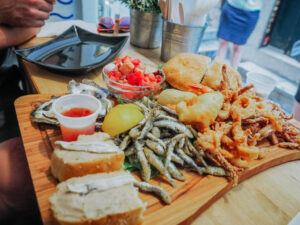
Whether you are going to stay in a hotel or are planning an independent holiday in Dubrovnik with children, one thing is absolutely certain: you need to visit a Croatian restaurant at least once.
The basis of its cuisine in the seaside city is fish and seafood, but the menu also includes healthy vegetable dishes and meat. All this does not need to be adapted for children’s tables. True, there are almost no unpretentious “taverns” in Dubrovnik; restaurants predominate here. Gourmets need to visit the town of Ston, where the best oysters of the Adriatic are grown. Another delicacy is eels caught in Neretva. You can buy food and baby food in any of the supermarkets, they are available in all areas. In the old town, not far from the Ascension Cathedral, there is a market in the mornings where they sell fresh fish, vegetables and fruits.
Transport:
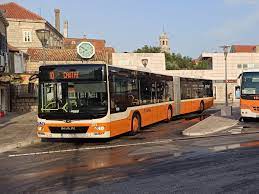
The public transport system in Dubrovnik is simple and convenient: there are several bus routes around the city, connecting the historical center with other areas. The most popular route among tourists is bus number 6, which goes from the old town to the Babin Kuk area, where the best beaches and hotels are located. The cost of a bus ride is 13 kuna when buying tickets at the box office and 15 kuna when buying from the driver. To save money, you can travel all day with a 30 kuna pass. Note that buses run regularly around the city, but not always often, so before the trip we recommend checking the schedule on the website of the Libertas carrier company. Bus number 6 runs more frequently than others: from 5:30 to 00:55 every 10-15 minutes.
Several buses run between Dubrovnik and the airport. Buses number 11, 27, 38 cost about 30 kuna, and the Atlas shuttle bus costs 40 kuna.

Modern intercity buses depart from Dubrovnik bus station to the resorts of Southern Dalmatia, to the cities of Croatia and neighboring countries. The fare depends on the distance: a ticket to Split costs approximately 130 kuna, to Sibenik – 175 kuna, to Zagreb – 225-250 kuna. However, intercity transport in Dubrovnik is not only buses. In the old town there is a funicular station that goes up Mount Srđ. Round-trip tickets for adults cost 130 kuna, tickets for children – 60 kuna. Well, at the port, tourists are awaited by excursion boats and ferries going to the islands. Taxis in Dubrovnik are relatively expensive. Each kilometer costs 8 kuna, another 25 kuna must be paid for boarding. Transfer from the airport will cost about 250-300 kuna. Traveling around Dubrovnik by car is a dubious pleasure. In summer, the city is overloaded with traffic, and it is difficult to find a parking space. Renting a car only makes sense if you want to travel around the country.
What to do:
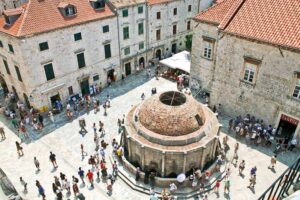
The program for a family vacation in old and beautiful cities is self-organizing: walks, sightseeing, panoramic photos from observation decks, and meals in picturesque restaurants. If you slightly adjust the standard plan, then a vacation with a child in Dubrovnik will turn into a small adventure – and this is remembered for a very long time. Getting to know the city, of course, will begin with a walk. But not around the city, but above it, along the fortress walls. Saturated colors – red roofs, blue sea, green islands – just beg to be captured on camera.
The length of the city walls is almost 2 km, and you can walk along them for a good two hours, stopping near the cannons and freezing when the wall turns into a 25-meter cliff. Then it’s worth going down and diving into the labyrinth of the old town, walking with your child along the main street Stradun, looking into narrow (and often very steep) alleys, looking at palaces and finding the Jesuit staircase, where one of the scenes from Game of Thrones was filmed.
The series based on the books by George Martin features many of Dubrovnik’s landmarks: Minčeta Tower, Lovrjenac Fortress, Sponza Palace, Gradac Park, Trsteno Arboretum. The image of the city of Qarta was taken over by the island of Lokrum.
And for evening walks, the pedestrian street Setaliste kralja Zvonimira, located between the old town and the Lapad Peninsula, is perfect. Trees grow along the promenade, there are restaurants, bike paths, mini-golf courses and playgrounds. You can take in the whole city from the top of Mount Srdj. A hiking trail leads to the mountain, but in just 4 minutes you can fly to a height of 400 meters in a cable car. There are observation decks on the upper platform of Srd. A child will be interested in visiting the Medova Dolina park at the foot of Srd. This is a farm with a mini-zoo and a vegetable garden where organic vegetables are grown. As such, there are no entertainment centers for children in Dubrovnik, but a good place for active recreation is the Sveta Ana adrenaline park in the village of Police. The list of activities is wide: a rope park, archery, zorbing, quad bike rides, paintball. And fresh air comes first.
If you need a day of silence after the noisy city, spend time with your children on the island of Lokrum.
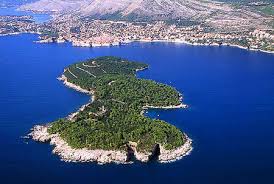
Almost its entire territory is occupied by a botanical garden, along the paths of which peacocks and rabbits walk. Lokrum is often called the Peacock Island, but the local “Dead Sea” is also often mentioned – a small lake with very salty water. Another place of peace and quiet is the arboretum in Trsteno. It was founded in the 15th century, and then plants brought by sailors from distant lands were planted here. Among the overseas curiosities are very old camphor trees from China, Himalayan cypress and Lebanese cedar. But what is even more surprising is that hummingbirds live in the arboretum. Since the choice of what to do in Dubrovnik with a child is not rich, why not look for entertainment in neighboring cities, even abroad? The road to Budva (Montenegro) takes about 2 hours, and it is worth going there for the sake of the largest water park on the Adriatic. There is another water park in Becici, near Budva.
Sea and beach:
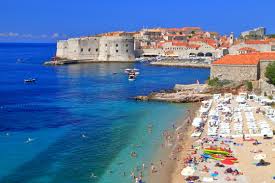
A beach holiday in Dubrovnik is not the main point of the program. And the reason is that the resort beaches are not very convenient for children, as they are concrete platforms.
But there are still several beaches for a seaside holiday with children in Dubrovnik. All of them are located on the Lapad Peninsula. On the eastern side, in a small bay, there is a small-pebble beach with a flat sandy bottom. The beach is well-equipped, safe and devoid of noisy entertainment. Bus No. 6 goes from the city center to the beach. There is a parking lot along the beach (which is nice, it is shaded by trees).
In the north of the Lapad Peninsula, in the Babin Kuk area, is the most famous beach in Dubrovnik – Copacabana. Its popularity is easy to explain: the crystal clear sea, gently sloping bottom, and a variety of entertainment attract tourists from all around. Therefore, in the high season, Copacabana is overcrowded with vacationers.
You can’t get to Copacabana by bus. The distance from the nearest bus stop No. 5, 6, 7 to the coast is about 500 meters. To enjoy a beach holiday, you can stay not in Dubrovnik, but at neighboring resorts. Cavtat is famous for its good pebble beaches. The sea here is quite shallow – this will appeal to children. The resort of Mlini has several different beaches, with small and large pebbles, with a gentle and steep entrance to the water.
Diving:
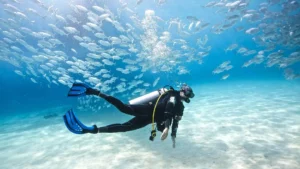
Even people who are not at all interested in diving notice the extraordinary transparency of the water in the Adriatic Sea. You can sail away from the shore by boat and see every pebble on the bottom through the thickness of the water. Imagine how tempting it is for diving enthusiasts! And there is much to see in the depths of the Adriatic: there are tropical fish, sharks, and sunken ships in the sea. There are several diving centers in Dubrovnik, where experienced divers can get a permit to dive (in Croatia this is necessary), and beginners can master basic skills. One of the best dive sites in South Dalmatia is located off the coast of Cavtat. In the depths of the sea lies a merchant ship that sank several thousand years ago. If you want to see underwater fauna, it is better to go to the Elaphite Islands: there, schools of fish swirl among the corals, and octopuses and moray eels can hide in the rocky crevices.
What to see:

There are more than 1000 attractions in Southern Dalmatia, so you are unlikely to have a problem finding what to see with children in Dubrovnik. But in order not to get lost in such a variety, we offer a list of the main museums of the city.
- Cultural and Historical Museum in the Prince’s Palace. The palace building, built in the Renaissance tradition, can safely be called the main exhibit of the museum. In the halls you can see antique furniture, weapons, coins, seals, maps and books.
- Ethnographic Museum. Another majestic building, although it is not a palace, but just a barn. Here you can see national costumes of the Croatians, household utensils, agricultural tools – everything is of good quality, and sometimes even decorated with an intricate pattern.
- Museum of Natural History. If you show your child a tree on which fish grow, or an aquarium where instead of air bubbles there are compact discs, he will definitely be surprised. Such an unusual way of presenting information awakens children’s curiosity, which means that a visit to the museum will be enjoyable and memorable.
- The Maritime Museum in the Fortress of St. John. One of the most interesting places for children with a very lively, despite the abundance of glass showcases, exposition. What is worth only one ship’s wheel in the middle of the hall or a two-meter anchor casually leaning against the wall.
- The Dubrovnik Aquarium. It is located in the same building as the Maritime Museum: the coolness of the old fortress harmonizes with the semi-darkness of the aquariums in which fish swim, starfish rest on the bottom, and sea anemones lazily move their tentacles.
- You can also visit the pharmacy at the Franciscan monastery in Dubrovnik with your child. It is believed that the pharmacy opened at the beginning of the 14th century and has not stopped working since then. Today, part of the pharmacy is occupied by a museum, but many tourists come here for useful gifts – natural cosmetics made according to ancient recipes.
For those who travel a lot and do not want to miss a single attraction, Dubrovnik has issued a tourist card. The Dubrovnik Card gives the right to free travel on public transport, as well as free entry to the city walls and all the city museums.
A card valid for 1 day is valid only in Dubrovnik. Three- and seven-day cards give the opportunity to go to Cavtat for free on bus No. 10 and visit three museums of this resort. The price of the Dubrovnik Card, depending on the validity period, is 190, 250 and 350 kuna. When buying online, a 10% discount is offered.
Nearby attractions:
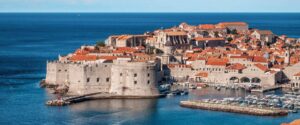
If you are planning a long holiday in Dubrovnik with children, the excursion program can be expanded. Only one day is needed for a trip to Cavtat or the islands, but for an excursion to the Plitvice Lakes or waterfalls on the Krka River, you need to allocate a couple of days.
The old town of Cavtat is as interesting as Dubrovnik: here, too, the city walls and fortifications from the times of the Dubrovnik Republic have been partially preserved. The list of the main tourist attractions includes the house-museum of the artist Vlaho Bukovac (his name is not well-known, but his paintings are definitely worth seeing) and the Račić Mausoleum (the white stone from which it is built was quarried on the island of Brač: the same stone was used to build Diocletian’s Palace in Split). In the town of Čilipi near Cavtat, there is the Heritage Museum. One exhibition contains a story about the everyday life and holidays of the Croats, about hard work and rest, about crafts and real art. The sights of the islands are different in spirit. For example, people go to the island of Mljet for the salt lakes and complete, simply incredible peace. If silence and nature do not put you into a trance, visit the Roman palace in Polač Bay and the 12th-century Benedictine monastery on an island in the middle of the Great Lake.
Tourists tend to visit the island of Korčula on weekends to see the knightly dance performance “Moreška”. While waiting for the performance, you can stroll through the old town of Korčula and visit the house of Marco Polo, which now houses a museum of the traveler.
Finally, from Dubrovnik it is easy to get to Montenegro by bus, and there are countless attractions there. The stairs of Herceg Novi, the intricate old town of Kotor, the medieval palaces of Tivat, the Budva Citadel – behind all this, you can forget that every city also has beaches.
Where to stay: areas and surroundings:
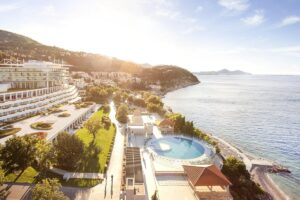
It is generally believed that the choice of where to stay in Dubrovnik lies between “expensive” and “very expensive”. This is partly true: hotel prices in Dubrovnik are higher than in other resorts in Croatia. But there is also budget accommodation here, without luxury, but with a range of services sufficient for a good holiday.
You need to choose where to stay in Dubrovnik with children based on the goals of your holiday.
If you are going to stay in the city for a couple of days to see the sights, look for accommodation in the center. The Pile area of Dubrovnik is the most expensive, since it is a historical building, but also the most respectable. Apartments are mainly rented here, and hotels are located outside the old city. Most of the “fives” and “fours” are located in the Ploce area, which adjoins Pile from the east. To relax in silence, closer to the beaches and not too far from the old city, choose accommodation on the Lapad Peninsula, including the Babin Kuk area. There are also expensive hotels, villas and apartments here, but you can also find affordable options. However, there are few family hotels, and only a couple of hotels have a games room, a children’s pool and a mini-club. A really important criterion when choosing a place where it is better to stay with children is the proximity to the beach – for these reasons, it is advisable to choose accommodation in the north and east of the Lapad Peninsula. The peninsula’s landscape is hilly, so many hotels and apartments are located on a hill. Much more places for a beach holiday are located in the vicinity of Dubrovnik. Accommodation in the resorts of Cavtat, Mlini, Slano is cheaper, and the beaches are more spacious. The islands near Dubrovnik are more focused on a romantic holiday than a family one.
By plane:
Dubrovnik International Airport is located 22 kilometers from the city center, near the town of Čilipi. The airport mainly receives summer flights from the UK, France, Germany, Spain and other European countries. You can get to Dubrovnik without transfers from Moscow. The flight schedule is available on the airport’s website.
How to get to Dubrovnik upon arrival::
- by Atlas shuttle bus (departure after each regular flight arriving at the airport) to the bus station;
- by Libertas municipal bus (several routes per day from the airport to Dubrovnik);
- by taxi;
- by rented car.
- By bus
Buses from other cities in Croatia arrive in Dubrovnik, including Zagreb, Split, Sibenik, Zadar, and the resorts of Southern Dalmatia. The journey from Split takes 4.5 hours, from Sibenik – 6.5 hours, from Zagreb – 12 hours. You can also get to Dubrovnik by bus from Budva, Kotor, Herceg Novi (Montenegro), travel time is 1.5-2.5 hours.
By car:
One of the most convenient ways to get to Dubrovnik is to rent a car. Rental company offices operate at airports and in major cities. Highway No. 8, or Jadranska Magistrala, leads to Dubrovnik. Travel on it is toll-based, and fares are paid at special points on the road.
Ferry:
Ferries from the islands of Kolocep, Lopud, Sipan, Mljet, as well as from Budva (Montenegro) and Bari (Italy) arrive at the port of Dubrovnik.
